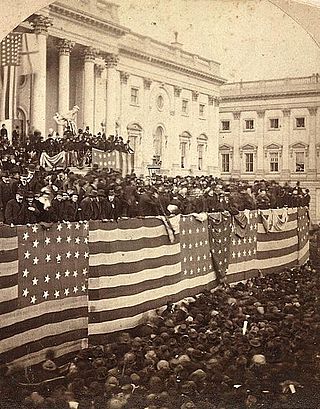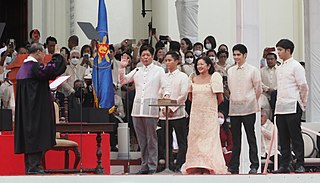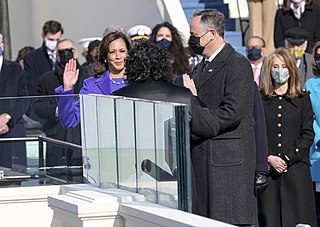
David Rice Atchison was a mid-19th century Democratic United States Senator from Missouri. He served as President pro tempore of the United States Senate for six years. Atchison served as a major general in the Missouri State Militia in 1838 during Missouri's Mormon War and as a Confederate brigadier general during the American Civil War under Major General Sterling Price in the Missouri Home Guard. Some of Atchison's associates claimed that for 24 hours—Sunday, March 4, 1849 through noon on Monday—he may have been Acting President of the United States. This belief, however, is dismissed by nearly all scholars.

The United States presidential line of succession is the order in which the vice president of the United States and other officers of the United States federal government assume the powers and duties of the U.S. presidency upon an elected president's death, resignation, removal from office, or incapacity.

The oath of office of the president of the United States is the oath or affirmation that the president of the United States takes upon assuming office. The wording of the oath is specified in Article II, Section One, Clause 8, of the United States Constitution, and a new president must take it before exercising or carrying out any official powers or duties.

The 31st United States Congress was a meeting of the legislative branch of the United States federal government, consisting of the United States Senate and the United States House of Representatives. It met in Washington, D.C., from March 4, 1849, to March 4, 1851, during the 16 months of the Zachary Taylor presidency and the first eight months of the administration of Millard Fillmore's. The apportionment of seats in this House of Representatives was based on the 1840 United States census. The Senate had a Democratic majority, while there was a Democratic plurality in the House.

Between 73 and 79 days after the presidential election, the president-elect of the United States is inaugurated as president by taking the presidential oath of office. The inauguration takes place for each new presidential term, even if the president is continuing in office for a second term.
Atchison County Historical Society Museum is a museum dedicated to preserving the history of Atchison County, Kansas. Both the city of Atchison and Atchison County, Kansas, are named after United States Senator and legendary "President for a day" David Rice Atchison.

The first inauguration of George Washington as the first president of the United States was held on Thursday, April 30, 1789, on the balcony of Federal Hall in New York City, New York. The inauguration was held nearly two months after the beginning of the first four-year term of George Washington as president. Chancellor of New York Robert Livingston administered the presidential oath of office. With this inauguration, the executive branch of the United States government officially began operations under the new frame of government established by the 1787 Constitution. The inauguration of John Adams as vice president was on April 21, 1789, when he assumed his duties as presiding officer of the United States Senate; this also remains the only scheduled inauguration to take place on a day that was neither January nor March.

The second inauguration of Ronald Reagan as president of the United States was held in a televised ceremony on January 20, 1985, at the White House, and was repeated the following day, January 21, 1985, at the Capitol's rotunda. This was the 50th presidential inauguration and marked the commencement of the second and final four-year term of both Ronald Reagan as president and of George H. W. Bush as vice president. At 73 years, 349 days of age on Inauguration Day, Reagan was the oldest U.S. president to be inaugurated, until Joe Biden's inauguration as president on January 20, 2021, at the age of 78 years, 61 days.

The second inauguration of Richard Nixon as president of the United States was held on Saturday, January 20, 1973, at the East Portico of the United States Capitol in Washington, D.C. This was the 47th inauguration and marked the commencement of the second and final term of both Richard Nixon as president and Spiro Agnew as vice president. Both Agnew and Nixon resigned within two years of this term. In December 1973, Gerald Ford replaced Agnew as vice president and in the following year, replaced Nixon as president. This made Nixon the first and, as of 2023, only person to be inaugurated four times as both president and vice president. Chief Justice Warren E. Burger administered both the presidential and vice presidential oaths of office. During the ceremony, Look With Pride On Our Flag, a song dedicated to President Nixon and composed by Hank Fort, was played.

The first inauguration of Richard Nixon as the 37th president of the United States was held on Monday, January 20, 1969, at the East Portico of the United States Capitol in Washington, D.C. This was the 46th inauguration and marked the commencement of the first and eventually only full term of both Richard Nixon as president and Spiro Agnew as vice president. Chief Justice Earl Warren administered the presidential oath of office to Nixon, and Senate Minority Leader Everett Dirksen administered the vice presidential oath to Agnew. Nixon was the first non-incumbent vice president to be inaugurated as president. This was also the last presidential oath administered by Chief Justice Warren.

The second inauguration of Dwight D. Eisenhower as president of the United States was held privately on Sunday, January 20, 1957, at the White House and publicly on the following day, Monday, January 21, 1957, at the East Portico of the United States Capitol; both located in Washington, D.C. This was the 43rd inauguration and marked the commencement of the second and final four-year term of both Dwight D. Eisenhower as president and Richard Nixon as vice president. Chief Justice Earl Warren administered the presidential oath of office after the Senate Minority Leader William Knowland swore in the vice president.

The inauguration of William Howard Taft as the 27th president of the United States was held on Thursday, March 4, 1909, at the Senate chamber inside the United States Capitol, Washington, D.C., instead of the regular East Portico due to blizzard. This was the 31st inauguration and marked the commencement of William Howard Taft's only term as president and James S. Sherman's only term as vice president.

The second inauguration of William McKinley as president of the United States was held on Monday, March 4, 1901, at the East Portico of the United States Capitol in Washington, D.C. This was the 29th inauguration and marked the commencement of the second and final term of William McKinley as president and the only term of Theodore Roosevelt as vice president. McKinley died 194 days into this term, and Roosevelt succeeded in the presidency.

The inauguration of Millard Fillmore as the 13th president of the United States, was held on Wednesday, July 10, 1850, at the House chamber inside the United States Capitol in Washington, D.C., following the death of President Zachary Taylor the previous day. This inauguration – the second non-scheduled, extraordinary inauguration to ever take place – marked the commencement of Millard Fillmore’s only term as president.

The inauguration of Rutherford B. Hayes as the 19th president of the United States took place publicly on Monday, March 5, 1877, at the East Portico of the United States Capitol in Washington, D.C. This was the 23rd inauguration and marked the commencement of the only four-year term of Rutherford B. Hayes as president and William A. Wheeler as vice president.

At 2:15 a.m. Eastern Time on September 20, 1881, Chester A. Arthur was inaugurated the 21st president of the United States. The inauguration marked the commencement of Chester A. Arthur's only term as president. The presidential oath of office was administered by New York Supreme Court Justice John R. Brady at Arthur's private residence in New York City. Two days later, Arthur underwent a second inauguration ceremony in Washington, D.C., with the oath administered by Morrison Waite, the Chief Justice of the United States. Arthur became president following the death of his predecessor James A. Garfield, who had been assassinated by a troubled office seeker, Charles J. Guiteau.

The first inauguration of Woodrow Wilson as the 28th president of the United States was held on Tuesday, March 4, 1913, at the East Portico of the United States Capitol in Washington, D.C. This was the 32nd inauguration and marked the commencement of the first four-year term of Woodrow Wilson as president and Thomas R. Marshall as vice president. Chief Justice Edward D. White administered the presidential oath of office to Wilson.

The inauguration of Warren G. Harding as the 29th president of the United States was held on Friday, March 4, 1921, at the East Portico of the United States Capitol in Washington, D.C. This was the 34th inauguration and marked the commencement of Warren G. Harding's only term as president and of Calvin Coolidge's only term as vice president. Harding died 2 years, 151 days into this term, and Coolidge succeeded to the presidency.

The inauguration of the president of the Republic of the Philippines is a ceremony marking the commencement of the six-year term of a president of the Philippines, who is both head of state and head of government. The inauguration is performed on June 30, as mandated by the 1987 Constitution. Under the older 1935 Constitution, the date was December 30, which is also Rizal Day; the last inauguration held on the older date was Ferdinand Marcos' second one on December 30, 1969. The most recent public presidential inauguration ceremony was that of President Bongbong Marcos, who began his six-year term in office on Thursday, June 30, 2022.

The oath of office of the vice president of the United States is the oath or affirmation that the vice president of the United States takes upon assuming the vice-presidency but before beginning the execution of the office. It is the same oath that members of the United States Congress and members of the president's cabinet take upon entering office.





















